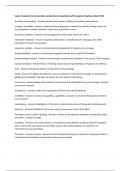Saylor Corporate Communication combo Review Questions with Complete Solutions Rated 100%
6 revision requirements - Answers format, facts, names, spelling, punctuation, and grammar
5 steps to evaluation - Answers understand the assignment, evaluate how well the writing carries out
the assignment, evaluate assertions, check facts, and look for errors
Evaluative feedback - Answers involves judgement of the writer and his/her ethos
Interpretive feedback - Answers requests confirmation or classification of a message and is often
expressed in the form of a question
supportive eedback - Answers communicates encouragement in response to a message
probing feedback - Answers communicates targeted requests for for specific information
Understanding feedback - Answers communicates sympathy and empathy for the source of the message
cognate strategies - Answers Ways of framing, expressing and representing a message to an audience.
Tone - Answers the general manner of expression of the message
clarity - Answers Strategies that help the receiver (audience) to decode the message, to understand it
quickly and completely, and when necessary, to react without ambivalence.
conciseness - Answers Being brief and direct in the visual and verbal delivery of your message, avoiding
unnecessary intricacy.
arrangement - Answers Order; the organization of visual (and verbal) elements.
credibility - Answers involves your qualities, capabilities, or power to elicit from the audience belief in
your character.
Expectations - Answers Anticipation of the norms, roles and outcomes of the speaker and the speech.
reference - Answers attention to the source and way you present your information.
five-finger model of public speaking - Answers Consists of the attention statement, introduction, body,
conclusion, residual message.
transitions - Answers are words, phrases, or visual devices that help the audience follow the speaker's
ideas, connect the main points to each other, and see the relationships you've created in the
information you are presenting.
Transition - internal previews - Answers a brief statement referring to a point you are going to make. It
can forecast or foreshadow a main point coming in your speech.
,Transition - Signpost - Answers alerts the audience that you are moving from one topic to the next.
These words draw attention to themselves and focus the audience's attention.
Transition - Internal Summaries - Answers briefly covers information or alludes to information
introduced previously. It can remind an audience of a previous point and reinforce information covered
in your speech.
Transition - Sequence transition - Answers outlines a hierarchical order or series of steps in your speech.
It can illustrate order or steps in a logical process
Transition - Time - Answers focuses on the chronological aspects of your speech order. Particularly
useful in a speech utilizing a story, this transition can illustrate for the audience progression of time.
Transition - addition - Answers contributes to a previous point. This transition can build on a previous
point and extend the discussion.
Transition - Similarity - Answers draws a parallel between two ideas, concepts, or examples. It can
indicate a common area between points for the audience.
Transition - Comparison - Answers draws a distinction between two ideas, concepts, or examples. It can
indicate a common or divergent area between points for the audience.
Transition - Contrast - Answers draws a distinction of difference, opposition, or irregularity between two
ideas, concepts, or examples. This transition can indicate a key distinction between points for the
audience.
Transition - Cause and Effect - Answers illustrates a relationship between two ideas, concepts, or
examples and may focus on the outcome or result. It can illustrate a relationship between points for the
audience.
Transition - Examples - Answers illustrates a connection between a point and an example or examples.
You may find visual aids work well with this type of transition.
Transition - Place - Answers refers to a location, often in a spatially organized speech, of one point of
emphasis to another. Again, visual aids work well when discussing physical location with an audience.
Transition - Clarification - Answers restates or further develops a main idea or point. It can also serve as
a signal to a key point.
Transition - Concession - Answers indicates knowledge of contrary information. It can address a
perception the audience may hold and allow for clarification.
Self - Understanding - Answers Public Commun starts with intrapersonal commun.
Self - Concept - Answers Where we place emphasis on. Doubts, fears, hopes.
Attitudes - Answers Learned predispositions to a concept or object. Subject to change.
, Beliefs - Answers Convictions or expressions of confidence. Can change over time.
Values - Answers Ideals that guide our behavior. Generally long lasting.
self-concept, Self - Image or Self - Esteem - Answers ____ ______ = self image + self esteem
______ ______ - how you would describe yourself to others. Physical characteristics + knowledge,
experiences, interests.
_____ _____ - feelings, self worth, self acceptance, self respect.
Closure - Answers Tendency to use previous knowledge to fill in the gaps of an incomplete idea or
picture.
Gestalt Princple - Answers Examine parts of things and make a whole complete picture regardless of
context.
Proximity - Answers Organizing based on relationship of space to objects
Continuity - Answers Drawing connections between things that occur in sequence
Similarity - Answers Grouping things based on properties they share
Uniformity/homogeniety - Answers noting ways objects are a alike.
Figure and Ground - Answers emphasis on a single item that stands out from its surroundings.
Symmetry - Answers balancing objects or ideas equally from one side to the other.
Nonverbal Communication - Answers is fluid, fast and can add or replace verbal communication,
universal, confusing and contextual, intentional or non intentional, communicate feelings and attitudes,
more than verbal,
Adaptors - Answers help us feel comfortable or indicate emotions/moods
Affect Displays - Answers Express feelings or emotion
Complementing - Answers Reinforcing verbal communication
Contradicting - Answers contradicting verbal communication
emblems - Answers nonverbal gestures that carry a specific meaning and can be replaced or reinforce
words
Illustrators - Answers Reinforce a verbal message




